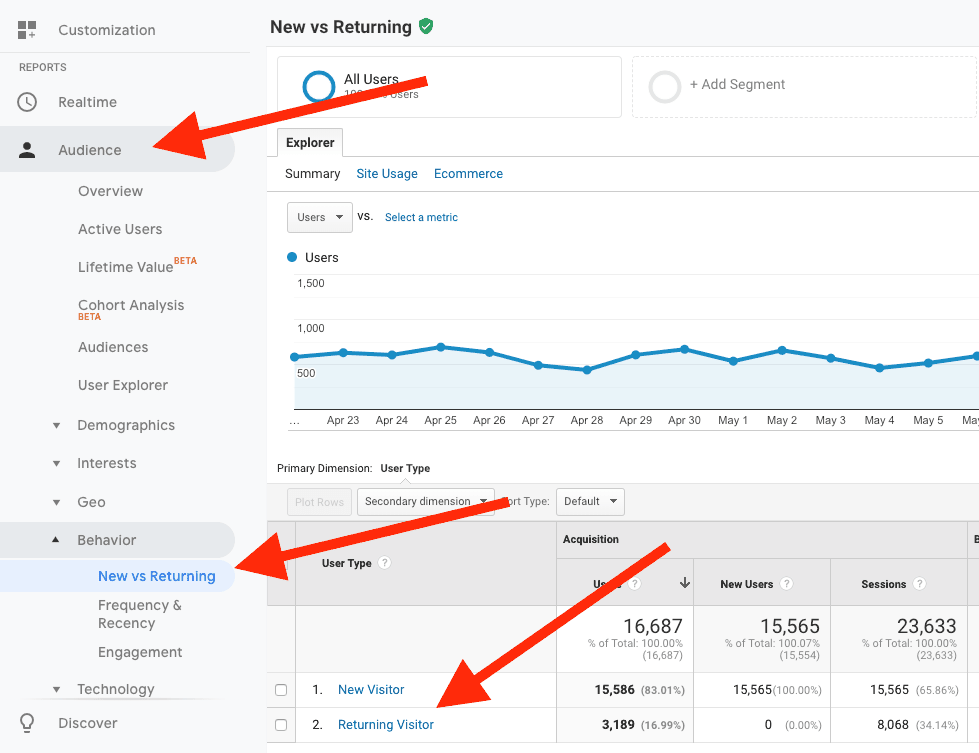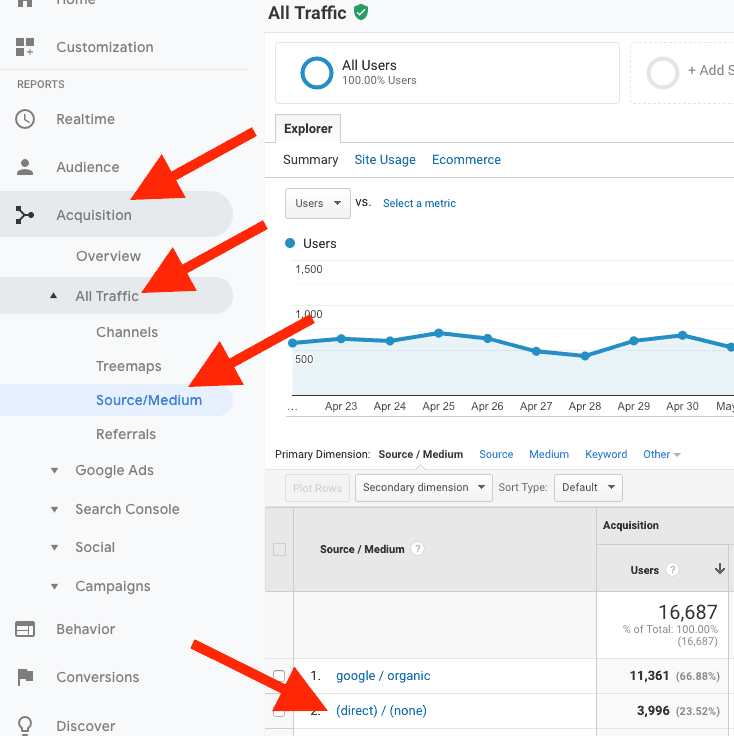Innkeeper: “The room is $15 a night. It’s $5 if you make your own bed.”
Guest: “I’ll make my own bed.”
Innkeeper: “Good. I’ll get you some nails and wood.”
Source: Unijokes.com
One mark of a quality niche site, in my view, is one with repeat visitors (or customers of course).
The more repeat visitors that visit frequently, the better.
It’s not easy to pull off, especially in many niches. Sure, popular news sites have plenty of repeat visitors because people want the news, but evergreen niche sites are more difficult because for many people they want certain info at a specific time and not again.
However, if you publish interesting content in addition to the dry “search content” stuff, you may be able to increase your repeat visitor metrics.
Below I explain why I think repeat visitors is a metric worth paying attention to and how to improve the metric.
A highly underrated metric
There’s plenty of discussion about time-on-site, bounce rate, number of page views per visitor as metrics to improve, but seldom is the percentage or absolute number of repeat visitors discussed.
In my view, repeat visitors is an important metric. I have no empirical evidence it’s good for SEO, but I can’t help but think it’s a good signal. After all, one very strong indicator of a quality website is that people visit it over and over.
Note, just because a site has plenty of repeat visitors does not mean it will clean up in the SERPs. Many other factors must be met (especially on-site SEO), however, having an above-average percentage of repeat visitors helps (in my opinion).
How to check your repeat visitor percentage
Below is a screenshot of Google Analytics showing you how to see your returning visitor data.
Another way to assess repeat visitor info
I like checking out the search volume for my sites’ names in Ahrefs. The more people that search for my sites, the better. Here’s how to check this info out in Ahrefs.

4 aspects to the repeat visitor metric
1. Percent of overall traffic that is repeat visitors
This is a decent metric but it’s also a bit vague in that you don’t know whether your repeat visitors come back one time or they come back repeatedly. Either way, a single revisit is better than nothing.
2. Frequency of visits by repeat visitors
This refers to how often repeat visitors revisit. Do your repeat visitors come only one more time on average or do you have readers that visit repeatedly?
3. The volume of searches for your website in Google
I believe this is an excellent metric for a website as it communicates to Google that people are directly seeking out your site. The Ahrefs screenshot above shows you how you can get an idea of how many times per month your niche site brand is searched. I keep tabs on this metric for all my sites.
4. Direct traffic to your website
Another excellent type of visitor is one who types your URL directly into their browser address bar. However, direct traffic as a metric can also be traffic via an email newsletter and other direct sources. Here’s how to check for direct traffic metrics in Google Analytics:
How to improve your repeat visitor numbers
1. Publish regularly
If you don’t publish regularly and repeat visitors figure that out (it doesn’t take long to figure out), they won’t swing by much. That said, I wouldn’t publish bad content for the sake of publishing content. I’d rather maintain high quality and publish less often even at the expense of readers visiting regularly. After all, if you publish garbage they won’t stop by ever.
2. Publish some content for readers (not just search terms)
I publish a lot of content based on the fact people search for the topic (i.e. keywords). I do this so I can get free traffic from Google. However, often content geared toward keywords isn’t the most engaging unless people are searching for the topic. For example, if on this site I publish an article about the best WordPress menu plugins, that topic only matters to people searching for a good menu plugin at the time. Chances are, visitors who swing by on their own accord don’t care.
However, if I publish a commentary, opinion piece or an article on a trending topic that has more universal appeal such as whether you should use a Google My Business page for your niche site, regular visitors will like it but, but there’s no search volume attached to that topic (except for some accidental long tails I happen to target).
fatstacksblog.com is a good example of working to strike a balance in this regard. For years I seldom published articles based on keyword research. Most of what I published has been articles I thought people would like at the time. The result is this site does not get all that much search traffic despite it being somewhat popular.
In recent months, I’ve adjusted this strategy and have started publishing articles that target searched keywords. Accordingly, you’ll see some boring list type articles and how-to stuff around here that’s not typical. The thing is, search traffic is growing fairly quickly since I started doing this.
Therefore, I try to strike a balance by publishing popular content (such as this article which doesn’t target any keywords intentionally) as well as topics in the niche that target searched keywords.
While email newsletters may not always be directly worth it financially in some niches (many niches actually), they do offer one benefit and that is the ability to send repeat visitors back to your site instantly and regularly. This is primarily what I use my email newsletter for in my niche sites. The cost of the AWeber autoresponder is high, yet I suspect that the value of sending repeat visitors to my niche site regularly is worth it SEO-wise. At best I breakeven cost-wise, which means I lose money because of the time it takes to create newsletters, however, I believe the repeat traffic is worth it.
4. Post to Facebook
Sadly, the days where free Facebook traffic could generate hundreds of thousands or millions of monthly visitors for smaller websites are over. It was fun while it lasted, but those days are long gone.
However, Facebook pages for niche sites are not totally useless. For me, Facebook spits out just enough traffic to justify paying each month to MeetEdgar to auto-post new content to my various niche site FB pages. Again, at best I breakeven but I believe even that trickle of repeat visitors (i.e. FB fans) is worth it SEO-wise.
5. My #1 method for repeat visitors
In March, I discovered a new traffic source that is free and plentiful where I can send previous visitors back to my site in seconds at no cost to me. In 10 weeks, I’m now able to send 400 to 700 visitors per day back to my bigger niche site. Those numbers are growing fast. The potential is awesome.
Moreover, I’m also earning additional ad revenue from those repeat visitors external to my site.
If my trajectory continues as it is, I’ll be able to send thousands of repeat visitors daily to my site by Christmas.
Not only is all that traffic profitable because there is no cost associated with this traffic source, but that amount of volume, in my view, will have a positive impact on my SEO metrics, specifically the repeat visitor metric.
I set out all the details about my #1 repeat visitor strategy here.

Jon Dykstra is a six figure niche site creator with 10+ years of experience. His willingness to openly share his wins and losses in the email newsletter he publishes has made him a go-to source of guidance and motivation for many. His popular “Niche site profits” course has helped thousands follow his footsteps in creating simple niche sites that earn big.








